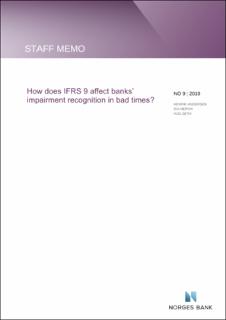| dc.contributor.author | Andersen, Henrik | |
| dc.contributor.author | Hjelseth, Ida Nervik | |
| dc.date.accessioned | 2020-05-01T07:50:42Z | |
| dc.date.available | 2020-05-01T07:50:42Z | |
| dc.date.issued | 2019 | |
| dc.identifier.isbn | 978-82-8379-123-5 | |
| dc.identifier.issn | 1504-2596 | |
| dc.identifier.uri | https://hdl.handle.net/11250/2653105 | |
| dc.description.abstract | IFRS 9 has changed the way banks recognise credit losses. Under IFRS 9, credit impairment shall be based on more forward-looking assessments by including recognition of expected credit losses. The purpose of this memo is to analyse how IFRS 9 affects the path of Norwegian banks’ credit losses in bad times. We analyse the effects of IFRS 9 by calculating and comparing the paths of banks’ credit losses under IAS 39 and IFRS 9 in the period 2001–2017. Our results suggest that IFRS 9 may increase impairment losses both immediately prior to and during bad times with increased credit risk. | en_US |
| dc.language.iso | eng | en_US |
| dc.publisher | Norges Bank | en_US |
| dc.relation.ispartofseries | Staff Memo;9/2019 | |
| dc.rights | Attribution-NonCommercial-NoDerivatives 4.0 Internasjonal | * |
| dc.rights.uri | http://creativecommons.org/licenses/by-nc-nd/4.0/deed.no | * |
| dc.subject | IFRS 9 | en_US |
| dc.subject | IAS 39 | en_US |
| dc.subject | credit losses | en_US |
| dc.subject | enterprises | en_US |
| dc.subject | credit risk | en_US |
| dc.title | How does IFRS 9 affect banks’ impairment recognition in bad times? | en_US |
| dc.type | Working paper | en_US |
| dc.description.version | publishedVersion | en_US |
| dc.subject.nsi | VDP::Samfunnsvitenskap: 200::Økonomi: 210::Samfunnsøkonomi: 212 | en_US |
| dc.source.pagenumber | 30 | en_US |

